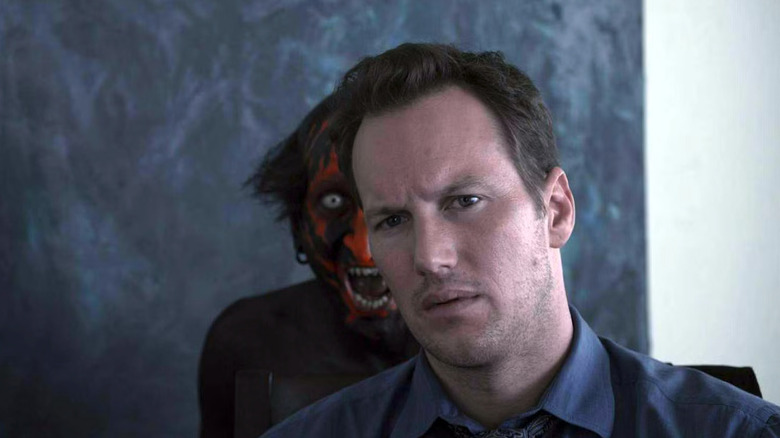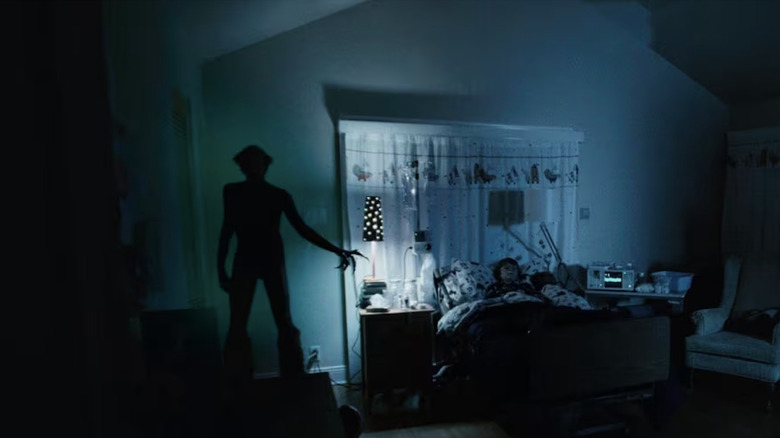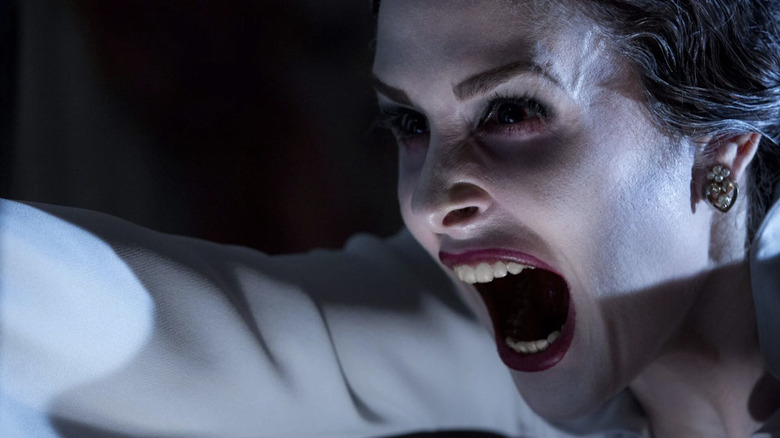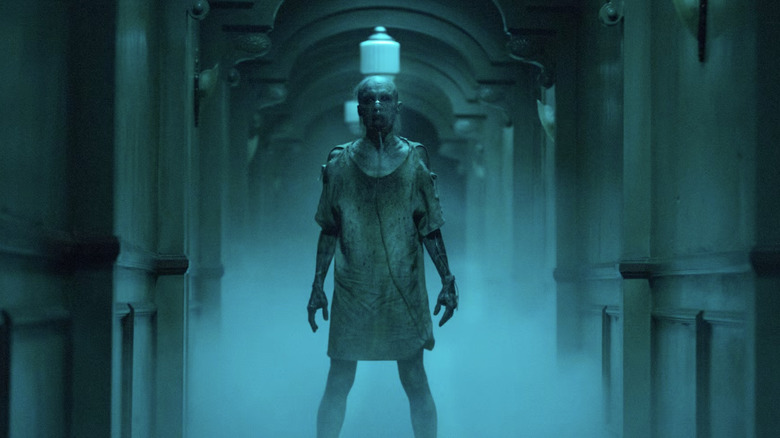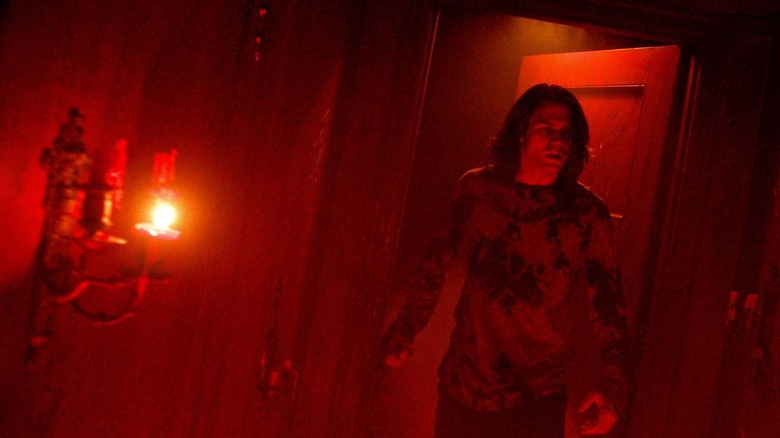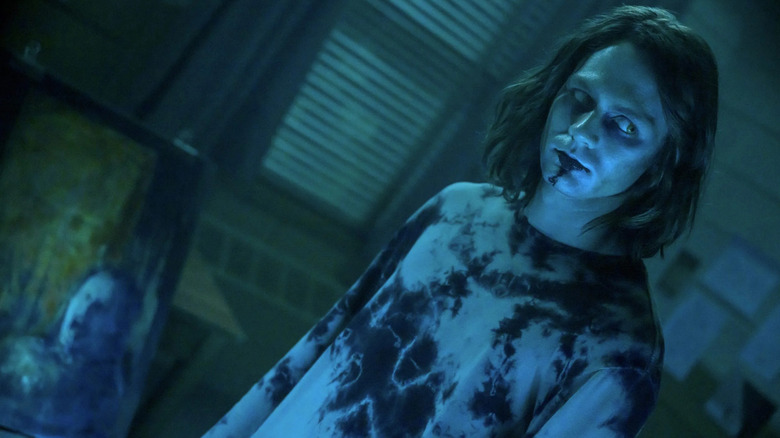How To Watch The Insidious Movies In Order
For 15 years now, the "Insidious" franchise has been scaring the daylights out of audiences with its story of ordinary families being plagued by ghosts and ghouls from the astral plane. Unlike other horror franchises, however, each chapter in the "Insidious" movie series has been spearheaded by the same set of creatives, which in this case includes director-producer James Wan and writer, director, and actor Leigh Whannell. This has, in turn, allowed the property to maintain a sense of consistency from one entry to the next, particularly when it comes to its PG-13 level scares.
So, if you've been wanting to take a trip to the astral plane, you might be wondering where to start. The "Insidious" franchise jumps backwards and forwards in time, to the degree there are now just as many prequels to the original film as there are sequels. Hence, it's easy to get confused about what the "correct" order to watch the films is. But have no fear, because /Film is here to guide you through the Further (and the "Insidious" movies along with it).
Insidious (2010)
After writing and directing the indie horror hit "Saw," which spawned a sprawling franchise of its own, James Wan and Leigh Whannell brought their own spin to the haunted house genre with 2010's "Insidious."
The film follows the Lambert family, including its patriarch Josh (Patrick Wilson) and matriarch Renai (Rose Bryne), as they are beset by ghosts as a result of their son Dalton (Ty Simpkins) and his ability to astral project his mind. When Dalton inexplicably falls into a coma and becomes a vessel for these demons, his parents call in a mysterious demonologist named Elise (played admirably by Lin Shaye) and her partners Specks (Whannell) and Tucker (Angus Sampson) to deal with the matter.
"Insidious" was a bonafide hit thanks in no small part to Whannell and Wan's passion for delivering scares. The result is a film full of hair-raising moments, which is why it arguably remains both the best installment in the franchise and an excellent starting point to dive in.
Insidious: Chapter 2 (2013)
When "Insidious" became a success, James Wan returned to the director's chair with this sequel, which was also a box office hit despite receiving a noticeably colder reception. Unfortunately, it commits the cardinal sin of many sequels by doubling down on the franchise's lore, in the process over-explaining what we've seen up to this point and thus lessening the impact of those ghouls lurking in the darkness of the original film. It also features a decidedly problematic twist that has only grown more dubious in the years since "Insidious: Chapter 2" opened in theaters.
At the very least, the film's plot gives Patrick Wilson a chance to really go for it (though to say more would require us to venture into spoiler territory), and in doing so, it cements him as one of cinema's premiere scream kings. Not only that, but Wilson would also become increasingly involved with these films creatively as they went along, as we'll be getting into later.
Insidious: Chapter 3 (2015)
While the next film is called "Insidious: Chapter 3," a more appropriate title would be "Insidious: Chapter 0." As that implies, the third movie in the franchise is actually a prequel to the original film. See, Leigh Whannell and James Wan made the choice to kill the demonologist Elise at the end of the first movie, but she was such an integral part of the film's success that they couldn't help but find a way to bring her back for "Chapter 2." So, by the time it came to make a third film, the pair decided to move away from the Lamberts entirely and hand the property over to Elise by telling the story of how she came out of retirement as a demon hunter in the first place.
"Chapter 3" is Whannell's directorial debut, and for his first at bat, he does an admirable job bringing the scares while also righting some of the heavy-handed wrongs of the previous entry in the franchise. Since then, Whannell has gone on to helm a pair of Universal monster horror reboots in the forms of "The Invisible Man" and "Wolf Man," further deepening his horror bonafides.
Seeing as it's a prequel, you could technically start with "Insidious: Chapter 3" and get a full dose of Elise's backstory, but you'd be depriving yourself of the character's mysterious presence in the original film (which then gives this prequel most of its power). However, whether you heed my advice or not, you should end up watching the same movie after this anyway, seeing as it's both a sequel and a prequel. Read on for more...
Insidious: The Last Key (2018)
While "Insidious: Chapter 3" is a prequel to the original film, it doesn't tie directly into "Insidious" other than by providing an origin story for Elise and her demon hunting partnership with Specks and Tucker. As such, "Insidious: The Last Key" functions as both a sequel to "Chapter 3" and a prequel to "Insidious," tying Elise's backstory with the astral plane into the Lambert's own history of possessions when Elise accidentally opens a mysterious red door and inadvertently releases the demon known as Keyface (Javier Botet).
Four films into the series, unfortunately, it starts to feel like "Insidious" has run out of ways to surprise its audience, making "The Last Key" feel like a retread of everything we've seen before. Moreover, as endearing as Lin Shaye's performance as Elise was in the original movie, making her the central character sucks the mystery out of her character and therefore makes her less interesting to watch.
That is why "The Last Key" is generally considered the worst of the "Insidious" films. Luckily, however, just when it looked like the franchise had reached the end of its shelf life, we got a sequel that doubled down on everything that made the first "Insidious" work like gangbusters to begin with.
Insidious: The Red Door (2023)
"Insidious" is, at its heart, the brainchild of James Wan and Leigh Whannell, who have remain involved in every installment of the property. But with "The Red Door," they also opened up this partnership to series lead Patrick Wilson. Having worked with Wan on several movies by this point, including both the "Conjuring" and "Aquaman" franchises, Wilson went from scream king to director with "The Red Door."
Wilson has been at the heart of the franchise's opening chapters, so it's only fitting he took on the role of director when the property returned to focus on the Lambert family once more. "The Red Door" explores the generational curse at the heart of the first two "Insidious" films, giving the Lamberts the chance to rid themselves of the (literal) demons that have been plaguing them for good. Having been the center of so many horror movies, Wilson crafted a sequel that stays true to the property's roots while also introducing a moody color palette that leans heavily into the dreamworld aesthetic of the larger "Insidious" franchise to great success.
You could, in all honesty, start and end your "Insidious" journey here, as the film acts as something of a reboot by refocusing on the Lambert family. At the same time, the movie works all the better if you go in already knowing everything the Lambers have been through over the years. Plus, you wouldn't really understand why the film devotes so much time to a scene featuring an old lady talking about demons on a video at one point.
Once you've closed "The Red Door," though, you'll have watched all the "Insidious" movies in order ... at least until "Insidious: Chapter 6" comes knocking.
Should you watch the Insidious movies in chronological order?
With "Insidious: Chapter 3" and "The Last Key" acting as prequels to "Insidious," you would be justified in wondering if you should follow the story of Elise and the Lambert family in chronological order.
While this is certainly doable, and would give Elise fans the chance to refashion the franchise around her, it would come at the expense of the larger story the "Insidious" property crafts across its first five movies. After all, the whole purpose of a prequel isn't to set up Easter eggs for the original; it's to deepen what we've seen before and provide new context for us as an audience to understand the larger narrative and themes being explored. Even if the prequels are only marginally successful, the point still stands that watching Elise team up with Specks and Tucker in "Chapter 3" only matters to us because we saw what their partnership is capable of in the original film.
Watching these movies chronologically would also lessen the impact of discovering the Red Door in "The Last Key," adding two more films that make no reference to it before we get to fully explore the consequences of Elise's actions when the Lambert family climatically closes it in the fifth installment.
So, go ahead and watch the films in chronological order, if you dare. Just don't say we didn't warn you...
